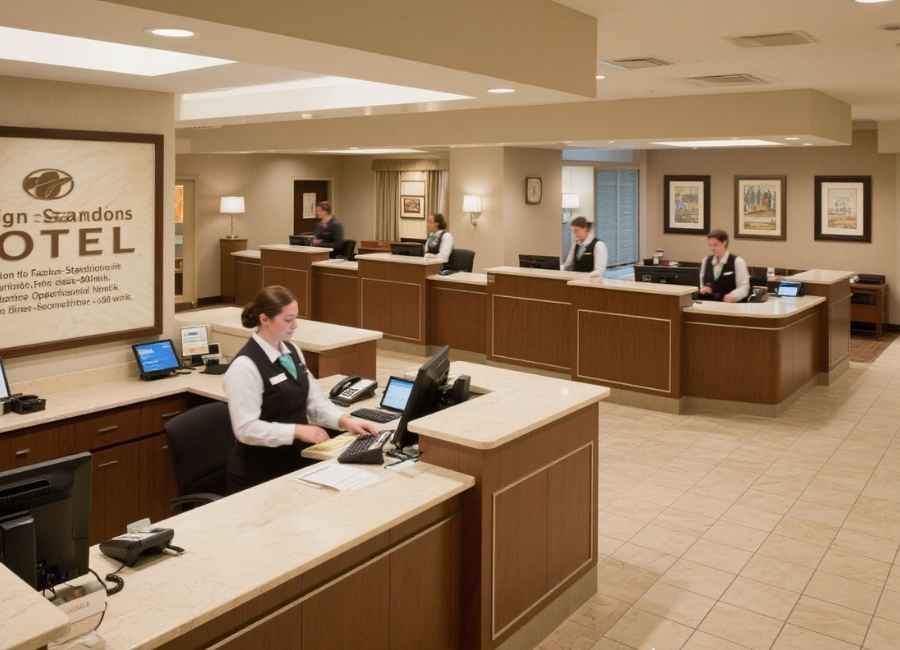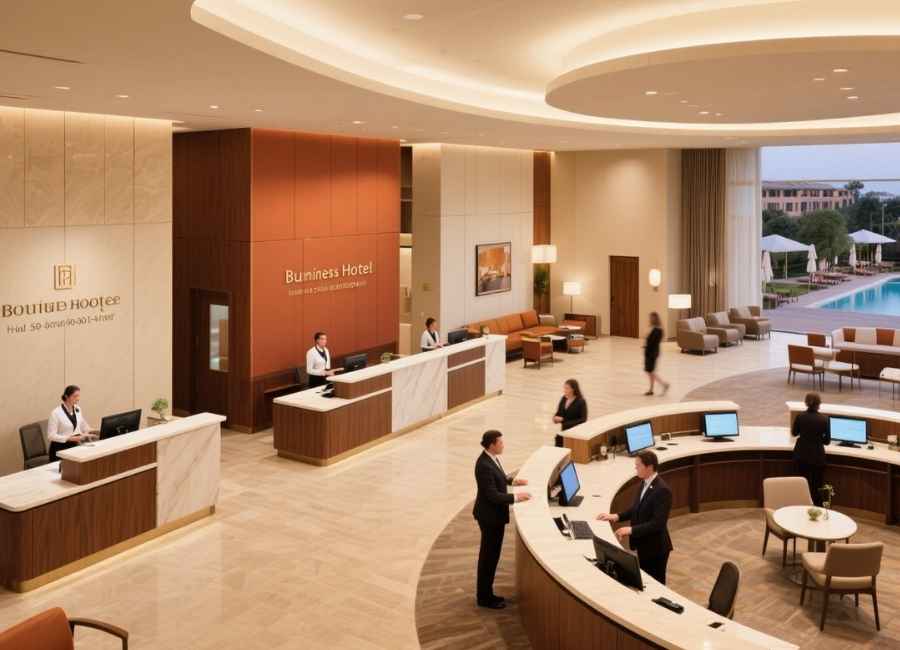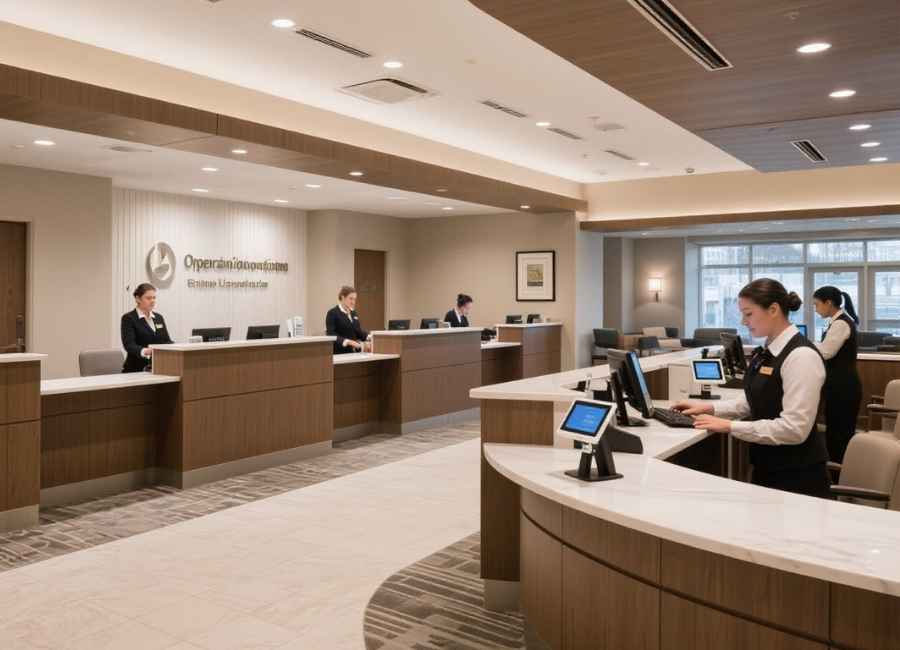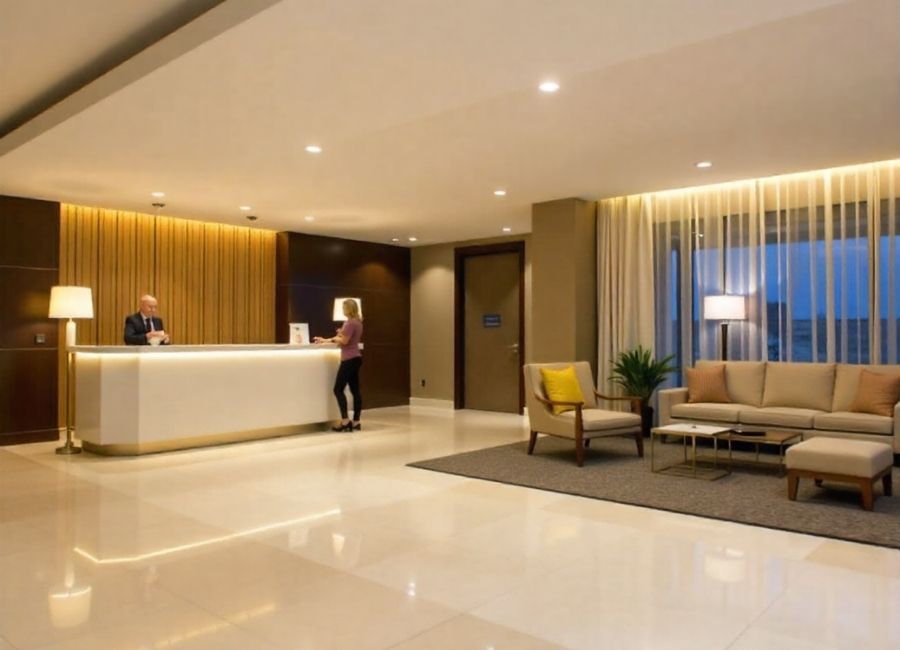When you enter a hotel lobby, the reception desk stands out as the central spot for check-ins, questions, and problem-solving. Some hotels have just one small desk, while others have several stations spread out. The number of reception desks is not random. Hotels determine this based on the number of guests they expect, the level of service they want to provide, and how smoothly they want things to run.
Understanding how hotels determine their reception desk needs can provide valuable insights for hospitality professionals, hotel developers, and curious travelers alike. Whether you’re planning a new property, optimizing existing operations, or fascinated by hotel design, the factors that influence reception desk configuration reveal much about the hospitality industry’s approach to guest service.
Factors That Determine Reception Desk Numbers

Hotel Size and Guest Capacity
The most obvious factor influencing reception desk quantity is the hotel’s size. A 50-room boutique hotel has vastly different needs than a 500-room convention center property. Generally, hotels allocate one reception desk position for every 75-100 rooms, though this ratio varies significantly based on other operational factors. (Essential Ratios and Standards for Front Office Operations, n.d.)
Smaller properties often operate efficiently with a single reception desk that serves multiple functions. Staff members might handle check-ins, concierge services, and phone calls from one central location. This approach works well when guest volume remains manageable and service expectations align with a more intimate, personalized experience.
Larger hotels require multiple reception positions to prevent long wait times during peak periods. A 400-room hotel might feature four to six reception desks, ensuring adequate coverage during busy check-in and checkout times while maintaining service quality standards. (Design Standards HOTEL March 2006, 2006)
Guest Turnover Patterns
Hotels with high daily turnover need more reception capacity than those with more extended average stays. Business hotels in urban centres often experience intense morning and evening rushes as guests check out before meetings and check in after work. These properties typically invest in additional reception desks to handle these predictable volume spikes.
Resort properties with week-long stays face different challenges. While they might have fewer daily check-ins, they often require more comprehensive services at each guest interaction. Resort reception desks frequently handle complex requests involving activities, dining reservations, and local excursions, requiring more time per guest and potentially more specialized stations.
Service Level Classifications
Luxury hotels maintain lower guest-to-reception-desk ratios to ensure personalized service. A five-star property might provide one reception position for every 40-50 rooms, allowing staff to spend more time with each guest and handle complex requests without creating bottlenecks. (How to Establish Standard Staffing Guidelines in Hotels: Complete Labor Control Framework, n.d.)
Budget and mid-scale properties typically operate with higher efficiency ratios. These hotels might have one reception desk for every 100-150 rooms, focusing on quick, efficient transactions rather than extended service interactions. (Hospitality Service Level Benchmarks: Optimizing Shift Management Excellence, n.d.) Self-service kiosks and mobile check-in options often supplement traditional reception desks in these properties.
Standard Reception Desk Configurations by Hotel Type

Boutique Hotels (50-150 rooms)
Most boutique properties operate with 1-2 reception desks, often integrated into a larger lobby design that emphasises style and ambience. These desks frequently serve multiple purposes, with staff handling reception duties, concierge services, and sometimes even restaurant reservations from a single location.
The intimate scale of boutique hotels allows for this consolidated approach while maintaining the personalized service that guests expect from smaller properties.
Business Hotels (150-300 rooms)
Business-focused properties typically feature 2-4 reception desks arranged in a linear or curved configuration. This setup accommodates the predictable rush periods common in business travel while providing adequate coverage during slower periods.
Many business hotels also incorporate express check-in/checkout desks or kiosks to serve guests with simple requests, freeing up full-service reception desks for more complex needs.
Full-Service Hotels (300-500 rooms)
Large full-service hotels usually operate 3-6 reception desks, often arranged in an island or curved configuration that maximizes efficiency and guest flow. These properties frequently designate specific desks for different services—general reception, VIP guests, group check-ins, or loyalty program members.
The reception area in these hotels becomes a carefully orchestrated operation with clear sight lines, logical guest flow patterns, and backup capacity for peak periods.
Resort Properties
Resort hotels base their reception desk numbers on peak occupancy and the complexity of services provided. A 300-room resort might have 4-5 reception desks during peak season, with some dedicated to arrival services and others handling ongoing guest needs throughout the stay. (Hospitality Service Level Benchmarks: Optimizing Shift Management Excellence, n.d.)
Many resorts also maintain separate activity desks or concierge stations that complement the main reception area, distributing service requests across multiple touchpoints.
Operational Considerations

Staffing Efficiency
The quantity of reception desks directly impacts staffing requirements and operational costs. Hotels must balance adequate service coverage with labor efficiency, especially during off-peak periods when guest volume drops significantly.
Smart hotel operators design flexible reception areas that can expand or contract based on demand. This might involve convertible desk spaces, mobile check-in stations, or cross-trained staff who can handle multiple functions as needed.
Technology Integration
Modern hotels increasingly supplement traditional reception desks with technology solutions. Mobile check-in, digital key systems, and self-service kiosks can reduce the burden on physical reception desks while maintaining service quality.
However, technology doesn’t eliminate the need for human interaction. Hotels still require adequate reception desk capacity for guests who prefer personal service, encounter issues with technology, or have complex requests requiring human assistance.
Peak Period Management
Successful hotels plan reception desk capacity around their busiest periods rather than average demand. This means having enough desks and staff to handle checkout rushes, large group arrivals, or special event periods without creating guest frustration.
Some hotels employ temporary or mobile reception stations during especially busy periods, expanding their capacity without permanently increasing their footprint or staffing requirements.
Design and Layout Impact
The physical design of reception desks affects both operational efficiency and guest experience. Islands and curved configurations allow better sight lines and guest flow management compared to linear arrangements. However, the optimal design depends on lobby layout, guest volume patterns, and service philosophy.
Reception desk positioning within the lobby also influences how many desks a hotel needs. Centrally located desks with good visibility might handle more guest interactions efficiently than poorly positioned desks that guests struggle to find.
Future Considerations
The hospitality industry continues evolving toward more flexible, technology-integrated service models. Hotels increasingly view reception desks as part of a broader guest service ecosystem that includes mobile apps, in-room tablets, and roaming staff members with mobile devices.
This evolution doesn’t necessarily reduce the number of reception desks hotels need, but it does change how those desks function and what services they provide. Future hotel designs might feature fewer traditional reception desks but more varied service touchpoints throughout the property.
Finding the Right Balance for Your Property
Determining the optimal number of reception desks requires careful analysis of your specific property’s needs, guest expectations, and operational constraints. Consider your peak occupancy periods, average length of stay, guest demographics, and service level goals when making this decision.
Remember that reception desks represent both a significant capital investment and an ongoing operational cost. However, inadequate reception capacity can severely impact guest satisfaction and operational efficiency. Work with experienced hospitality consultants or study similar properties in your market to inform your decision-making process.
The number of reception desks your hotel needs is not only about serving guests. It also helps set the right first impression and builds a strong foundation for your entire property.











